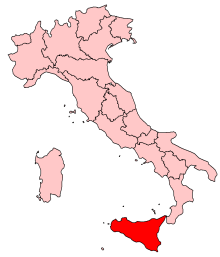Introduction to the region: Sicily
Sicily is the largest region in Italy, and I hope to visit many more times as I still have more to explore. The east and the west are quite distinct and, as I have understood, have a pseudo rivalry.
Take a simple example: people from all over the world are familiar with the regional and delectable fried rice balls, arancini (or arancine). Which is correct, arancino or arancina? The ‘correct’ answer depends on geography. In Eastern Sicily (Catania) the masculine arancino is used and in Western Sicily (Palermo) the delicious fried snack is considered feminine, that is, arancina. This dispute illustrates the diversity even within this one region, albeit the largest region by volume.
The Greek influence in these southern regions (Puglia and Calabria included) is fascinating and palpable, and in addition to obvious signs in the architecture, it is evident in the cuisine and even in the people. You may have heard the expression “una faccia, una razza” which translates to “one face, one race.” The phrase comes from a film called Mediterraneo which won the Academy Award for Best Foreign Language film in 1992. The film is set during World War II and features a group of Italian soldiers that become stranded on a Greek island. The townspeople hide, fearing the return of German soldiers, until they realize that the Italians will not cause them any harm. The famous quotation embodies one of the films themes, which is, in fact, the past and present connection of the Greek and Italian people, Sicilians, in particular.
The architectural influence is evident in the ancient Greek theatres and temples you will find across the island of Sicily. I will explore the Greek theatre complexes at Taormina and Siracusa in the subsequent posts, but there are also the archeological sites of Sagesta (near the west coast) and Agrigento in the southwest of the island, though nearing the central southern point. The Temple of Sagesta is Doric in style and was built in the 5th century BCE by an ancient indigenous people of Sicily called the Elymians. Although the Elymians are said to have inhabited Sicily since about 1200 BCE, they assimilated with the Greeks when they arrived about 5 centuries later. The Valley of the Temples in Agrigento is a complex of temples that is considered the best representation the architecture in the Magna Grecia, which means “Greater Greece.” The area was founded as a Greek colony in the 6th century BCE and many of the temples were built in the 6th, 5th and 4th pre-Roman centuries that followed.
On a related note, you will probably notice the omnipresent symbol of a three legged figure around what looks like the head of medusa.This figure, known as the Trinacria or Triskelion, is indeed represented on the official flag of Sicily, and the central gorgon head, of course, connects to the Greek heritage. The three legs further represent the three promontories of Sicily, namely, Cape Pelorus, Cape Passero, and Cape Lilibeo.
The size of Sicily should not be underestimated if you are planning a visit. It is “the largest island in the Mediterranean Sea”. It takes about 2 hours and thirty minutes to drive from Palermo to Catania, but as mentioned, the cultural jewels are all around the coasts. Thus, driving the perimeter takes much longer. If you have more than a week (maybe about two weeks, depending on how you travel) you could plan to see the full island, or choose one coast.
The population of Sicily is about 5 million, and it is a fascinating, diverse, large island. It is, unfortunately, still plagued by associations with the Mafia. Although more and more, these associations manifest more in intrigue than fear thanks to romanticized representations in American film and television. Many American tourists desire to visit Corleone. Now there is a Mafia museum to accommodate these interests. Supposedly, the tower (part of the Castello) in the town named ‘Soprano’ inspired the name of the HBO drama. (Someone from the town who profits off of this Mafia tourism told me this anecdote, so I do not have proper sources to site, only his word.) The Teatro Massimo in Palermo famously appears in the final scene of the Godfather Part III. Find out more in the regional features post. My mom travels with a tour company called OAT, and she spent two full weeks exploring the extent of the island. I met her in Palermo for the beginning of the trip, but then had to return to Rome to teach. Thus, my mom is technically more of a Sicilian authority than I am, hehe. I am still in contact with her wonderful guide, Dario. If you are interested in an excellent guide for Sicily, I can put you in touch with him.
To end on a literary note, Goethe spent only 40 days in Sicily, but his potent words have resonated with many foreign visitors over the last 230 years. Famously, he wrote, “without Sicily, Italy creates no image in the soul: Here is the key to everything.” Find out more about Goethe’s travels in Sicily here.




